宁夏PPT英文介绍
- 格式:ppt
- 大小:4.66 MB
- 文档页数:24

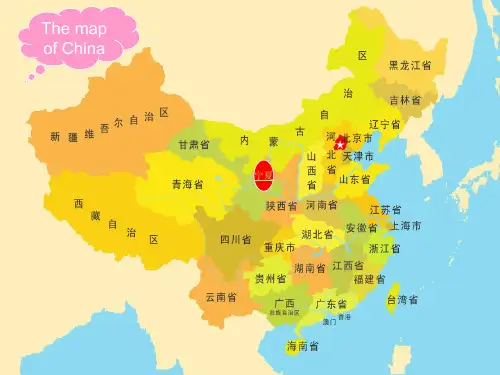
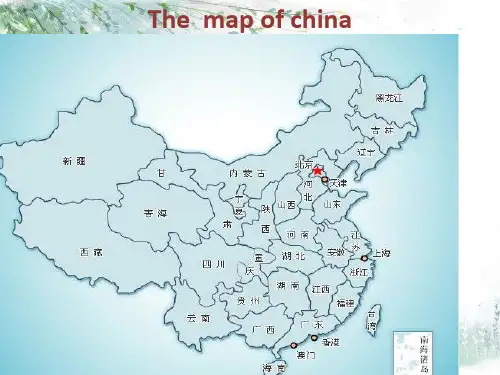
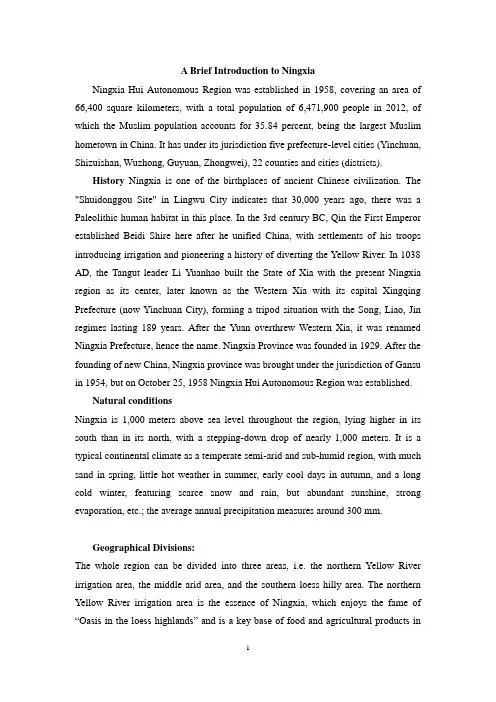
A Brief Introduction to NingxiaNingxia Hui Autonomous Region was established in 1958, covering an area of 66,400 square kilometers, with a total population of 6,471,900 people in 2012, of which the Muslim population accounts for 35.84 percent, being the largest Muslim hometown in China. It has under its jurisdiction five prefecture-level cities (Yinchuan, Shizuishan, Wuzhong, Guyuan, Zhongwei), 22 counties and cities (districts).History Ningxia is one of the birthplaces of ancient Chinese civilization. The "Shuidonggou Site" in Lingwu City indicates that 30,000 years ago, there was a Paleolithic human habitat in this place. In the 3rd century BC, Qin the First Emperor established Beidi Shire here after he unified China, with settlements of his troops introducing irrigation and pioneering a history of diverting the Yellow River. In 1038 AD, the Tangut leader Li Yuanhao built the State of Xia with the present Ningxia region as its center, later known as the Western Xia with its capital Xingqing Prefecture (now Yinchuan City), forming a tripod situation with the Song, Liao, Jin regimes lasting 189 years. After the Yuan overthrew Western Xia, it was renamed Ningxia Prefecture, hence the name. Ningxia Province was founded in 1929. After the founding of new China, Ningxia province was brought under the jurisdiction of Gansu in 1954, but on October 25, 1958 Ningxia Hui Autonomous Region was established.Natural conditionsNingxia is 1,000 meters above sea level throughout the region, lying higher in its south than in its north, with a stepping-down drop of nearly 1,000 meters. It is a typical continental climate as a temperate semi-arid and sub-humid region, with much sand in spring, little hot weather in summer, early cool days in autumn, and a long cold winter, featuring scarce snow and rain, but abundant sunshine, strong evaporation, etc.; the average annual precipitation measures around 300 mm.Geographical Divisions:The whole region can be divided into three areas, i.e. the northern Yellow River irrigation area, the middle arid area, and the southern loess hilly area. The northern Yellow River irrigation area is the essence of Ningxia, which enjoys the fame of “Oasis in the loess highlands” and is a key base of food and agricultural products inChina. The middle arid area is a desert or semi-desert zone ecologically. Surrounded by Tengri Desert, Ulan Buh Desert and Mu Us Desert, the middle arid area is dry without much rain, featuring poor living conditions, with windy, sandy weather and barren land. The southern mountainous area is covered with mountains and valleys and sparse vegetation, with severe water loss and soil erosion, and with part of the territory damp and cold. So it is a key area for China’s poverty alleviation work together with the middle arid area, with economic and social development lagging behind.Advantages in ResourcesNingxia boasts the comparative advantage of agriculture, energy and tourism, thus manifesting broad development prospects. First, the agricultural advantages. We have 1.107 million hectares of arable land, ranking No. 3 in China in terms of per-capita land, including 460,000 hectares with irrigation provided by the Yellow River, so it is one of China's 12 commodity grain production bases; we have 2.274 million hectares of pasture as one of the top ten pastoral areas. Second, the energy advantage. Four billion cubic meters of Yellow River water is available for us, accounting for about 10% of the total allocation; we have proven coal reserves of over 30 billion tons, ranking No. 6 in China. Ningdong Coalfield boasts 27.3 billion tons of proven reserves as one of the six huge mines to be developed as a national priority; we have 12 existing large and medium-sized power plants, with an annual generating capacity of 39.3 billion kilowatts-hour, or 6,550 kilowatts-hour per capita, ranking No.1 in China; with 50 kinds of proven mineral resources, the latent value of our natural resources per capita is 163.59 percent of the national average, ranking No. 5 in China. Third, tourism advantages. Ancient Yellow River civilization, the mysterious Western Xia history, rich folkways in Hui hometown style and magnificent desert scenery constitute a colorful variety of our unique tourist resources. Ningxia is trying to build itself up as an international tourist destination with unique West China characteristics.InfrastructureIn the region, there is a highway network stretching nearly 25,000 km, of which 1,323km is expressway, so that it takes only one hour for each city and county to reach the expressway. The region's administrative villages are all accessible by roads, electricity, telephone, radio and television. There are 35 various kinds of development zones and industrial parks, in which three are national-level development zones. These development zones have complete infrastructure, with prominent product features and comprehensive supporting functions, thus providing a big platform for adapting to industrial transfer.Two Major Strategies:Along the Yellow River, there are 10 cities in Ningxia. With more than 90% of Ningxia’s GDP and 94% of Ningxia’s fiscal revenue, it is an essential zone of Ningxia. The Ningxia Yellow River Economic Zone is one of the 18 main functional areas with key inputs from the central government, which has been written into the Outline of the "Twelfth Five-Year Plan" and become a national strategy. The Liupanshan Mountain area of Ningxia covers a vast land with a relatively big population and slow development. It is zo ned as a key point of China’s new round of poverty alleviation and development. To grasp these policy opportunities of the central government supporting Ningxia’s development, Ningxia proposes to vigorously carry out the two major strategies of Yellow River-front economic zone development and poverty alleviation for millions of poor people, so as to accelerate the construction of a harmonious and wealthy new Ningxia, and strive to realize the goal of an overall well-off society simultaneously with the other parts of China. This is not only a key point of economic and social development, but also a new opportunity for foreign investors in Ningxia.Construction of the Two Zones:In September 2012, China’s State Council approved the Ningxia Inland Opening-up Pilot Economic Zone and Yinchuan Comprehensive Bonded Zone. The Ningxia Inland Opening-up Pilot Economic Zone is the first and only pilot zone covering the whole region in inland China. It is oriented as “China’s strategic highland opening to the west, China’s important energy and chemical industry base, and China’s major industrial cluster of halal food and Muslim commodity as well as demonstration zoneof industrial transfer”. As one of the only three bonded zones in Northwest China, the Yinchuan Comprehensive Bonded Zone enjoys great preferential policies in terms of tax, trade regulations, bonded supervision, foreign exchange administration, etc. it will be built up as one of the special regulated areas with the highest opening-up level, the most preferential government policies, the most complete functions, the simplest procedures and the most prominent location advantages. The launching of the two zones’ not only is a major historic opportunity for Ningxia’s development, but also provides a new platform for China, Arab states and other Muslim regions to strengthen economic, trade and cultural exchange and cooperation, to adapt to global industrial transfer, to fully make use of international resources and market, and to expand the scale of the processing trade.Our achievementsIn recent years, Ningxia's socioeconomic cause embarked on a track of sustained, rapid and healthy development, and for 12 consecutive years our economic growth rate has surpassed the national average. With the reform and opening up in full swing, we have initial success in economic structural adjustment, witnessing significant changes in urban and rural areas, and people's living standards have been greatly improved. In 2012, we achieved GDP 232.664 billion yuan, up 11.5%; fiscal revenue 46.01 billion yuan, up 23.9%; the social investment of fixed assets 210.952 billion yuan, an increase of 27.5%; the total retail sales of consumer goods 54.88 billion yuan, up 14.9%; per capita disposable income of urban residents 19,831 yuan, an increase of 12.8%, rural per capita net income of 6,180 yuan, an increase of 14.2%.。
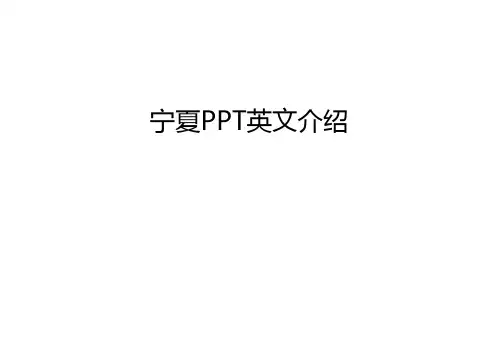
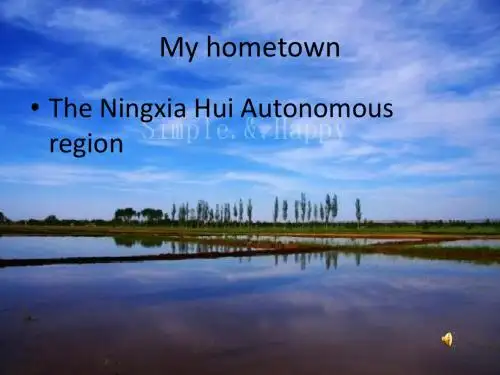
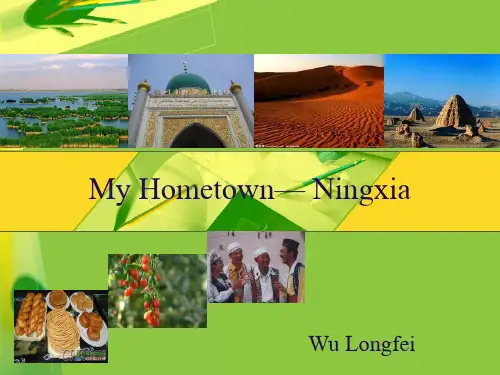


英文版-宁夏概况ABriefIntroductiontoNingxiaA Brief Introduction to NingxiaNingxia Hui Autonomous Region was established in 1958, covering an area of 66,400 square kilometers, with a total population of 6,471,900 people in 2012, of which the Muslim population accounts for 35.84 percent, being the largest Muslim hometown in China. It has under its jurisdiction five prefecture-level cities (Yinchuan, Shizuishan, Wuzhong, Guyuan, Zhongwei), 22 counties and cities (districts).History Ningxia is one of the birthplaces of ancient Chinese civilization. The "Shuidonggou Site" in Lingwu City indicates that 30,000 years ago, there was a Paleolithic human habitat in this place. In the 3rd century BC, Qin the First Emperor established Beidi Shire here after he unified China, with settlements of his troops introducing irrigation and pioneering a history of diverting the Yellow River. In 1038 AD, the Tangut leader Li Yuanhao built the State of Xia with the present Ningxia region as its center, later known as the Western Xia with its capital Xingqing Prefecture (now Yinchuan City), forming a tripod situation with the Song, Liao, Jin regimes lasting 189 years. After the Yuan overthrew Western Xia, it was renamed Ningxia Prefecture, hence the name. Ningxia Province was founded in 1929. After the founding of new China, Ningxia province was brought under the jurisdiction of Gansu in 1954, but on October 25, 1958 Ningxia Hui Autonomous Region was established.Natural conditionsNingxia is 1,000 meters above sea level throughout the region, lying higher in its south than in its north, with a stepping-down drop of nearly 1,000 meters. It is a typical continentalclimate as a temperate semi-arid and sub-humid region, with much sand in spring, little hot weather in summer, early cool days in autumn, and a long cold winter, featuring scarce snow and rain, but abundant sunshine, strong evaporation, etc.; the average annual precipitation measures around 300 mm.Geographical Divisions:The whole region can be divided into three areas, i.e. the northern Yellow River irrigation area, the middle arid area, and the southern loess hilly area. The northern Yellow River irrigation area is the essence of Ningxia, which enjoys the fa me of “Oasis in the loess highlands” and is a key base of food and agricultural products inChina. The middle arid area is a desert or semi-desert zone ecologically. Surrounded by Tengri Desert, Ulan Buh Desert and Mu Us Desert, the middle arid area is dry without much rain, featuring poor living conditions, with windy, sandy weather and barren land. The southern mountainous area is covered with mountains and valleys and sparse vegetation, with severe water loss and soil erosion, and with part of the territory damp and cold. So it is a key area for China’s poverty alleviation work together with the middle arid area, with economic and social development lagging behind.Advantages in ResourcesNingxia boasts the comparative advantage of agriculture, energy and tourism, thus manifesting broad development prospects. First, the agricultural advantages. We have 1.107 million hectares of arable land, ranking No. 3 in China in terms of per-capita land, including 460,000 hectares with irrigation provided by the Yellow River, so it is one of China's 12 commodity grain production bases; we have 2.274 million hectares of pastureas one of the top ten pastoral areas. Second, the energy advantage. Four billion cubic meters of Yellow River water is available for us, accounting for about 10% of the total allocation; we have proven coal reserves of over 30 billion tons, ranking No.6 in China. Ningdong Coalfield boasts 27.3 billion tons of proven reserves as one of the six huge mines to be developed as a national priority; we have 12 existing large and medium-sized power plants, with an annual generating capacity of 39.3 billion kilowatts-hour, or 6,550 kilowatts-hour per capita, ranking No.1 in China; with 50 kinds of proven mineral resources, the latent value of our natural resources per capita is 163.59 percent of the national average, ranking No. 5 in China. Third, tourism advantages. Ancient Yellow River civilization, the mysterious Western Xia history, rich folkways in Hui hometown style and magnificent desert scenery constitute a colorful variety of our unique tourist resources. Ningxia is trying to build itself up as an international tourist destination with unique West China characteristics.InfrastructureIn the region, there is a highway network stretching nearly 25,000 km, of which 1,323km is expressway, so that it takes only one hour for each city and county to reach the expressway. The region's administrative villages are all accessible by roads, electricity, telephone, radio and television. There are 35 various kinds of development zones and industrial parks, in which three are national-level development zones. These development zones have complete infrastructure, with prominent product features and comprehensive supporting functions, thus providing a big platform for adapting to industrial transfer.Two Major Strategies:Along the Yellow River, there are 10 cities in Ningxia. With more than 90% of Ningxia’s GDP and 94% of Ningxia’s fiscal revenue, it is an essential zone of Ningxia. The Ningxia Yellow River Economic Zone is one of the 18 main functional areas with key inputs from the central government, which has been written into the Outline of the "Twelfth Five-Year Plan" and become a national strategy. The Liupanshan Mountain area of Ningxia covers a vast land with a relatively big population and slow development. It is zo ned as a key point of China’s new round of poverty alleviation and development. To grasp these policy opportunities of the central government supporting Ningxia’s development, Ningxia proposes to vigorously carry out the two major strategies of Yellow River-front economic zone development and poverty alleviation for millions of poor people, so as to accelerate the construction of a harmonious and wealthy new Ningxia, and strive to realize the goal of an overall well-off society simultaneously with the other parts of China. This is not only a key point of economic and social development, but also a new opportunity for foreign investors in Ningxia.Construction of the Two Zones:In September 2012, China’s State Council approved the Ningxia Inland Opening-up Pilot Economic Zone and Yinchuan Comprehensive Bonded Zone. The Ningxia Inland Opening-up Pilot Economic Zone is the first and only pilot zone covering the whole region in inland China. It is ori ented as “China’s strategic highland opening to the west, China’s important energy and chemical industry base, and China’s major industrial cluster of halal food and Muslim commodity as well as demonstration zone of industrial transfer”. As one of the only three bondedzones in Northwest China, the Yinchuan Comprehensive Bonded Zone enjoys great preferential policies in terms of tax, trade regulations, bonded supervision, foreign exchange administration, etc. it will be built up as one of the special regulated areas with the highest opening-up level, the most preferential government policies, the most complete functions, the simplest procedures and the most prominent location advantages. The launching of the two zones’ not only is a major historic opportunit y for Ningxia’s development, but also provides a new platform for China, Arab states and other Muslim regions to strengthen economic, trade and cultural exchange and cooperation, to adapt to global industrial transfer, to fully make use of international resources and market, and to expand the scale of the processing trade.Our achievementsIn recent years, Ningxia's socioeconomic cause embarked on a track of sustained, rapid and healthy development, and for 12 consecutive years our economic growth rate has surpassed the national average. With the reform and opening up in full swing, we have initial success in economic structural adjustment, witnessing significant changes in urban and rural areas, and people's living standards have been greatly improved. In 2012, we achieved GDP 232.664 billion yuan, up 11.5%; fiscal revenue 46.01 billion yuan, up 23.9%; the social investment of fixed assets 210.952 billion yuan, an increase of 27.5%; the total retail sales of consumer goods 54.88 billion yuan, up 14.9%; per capita disposable income of urban residents 19,831 yuan, an increase of 12.8%, rural per capita net income of 6,180 yuan, an increase of 14.2%.。
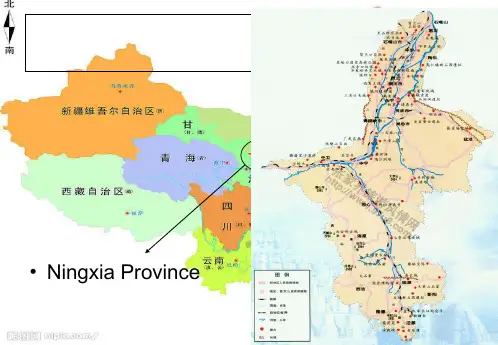
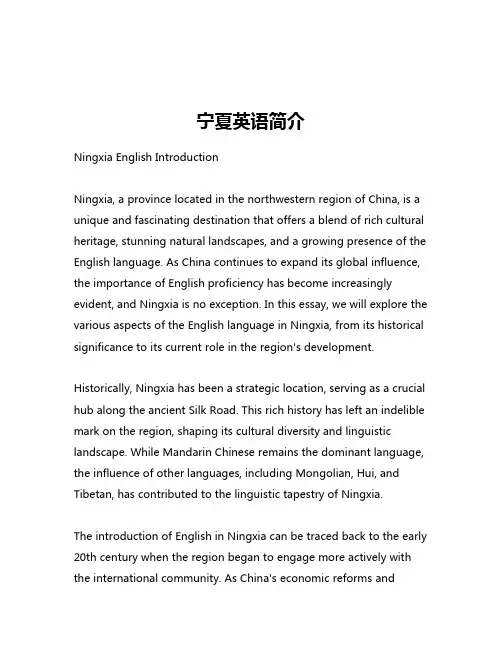
宁夏英语简介Ningxia English IntroductionNingxia, a province located in the northwestern region of China, is a unique and fascinating destination that offers a blend of rich cultural heritage, stunning natural landscapes, and a growing presence of the English language. As China continues to expand its global influence, the importance of English proficiency has become increasingly evident, and Ningxia is no exception. In this essay, we will explore the various aspects of the English language in Ningxia, from its historical significance to its current role in the region's development.Historically, Ningxia has been a strategic location, serving as a crucial hub along the ancient Silk Road. This rich history has left an indelible mark on the region, shaping its cultural diversity and linguistic landscape. While Mandarin Chinese remains the dominant language, the influence of other languages, including Mongolian, Hui, and Tibetan, has contributed to the linguistic tapestry of Ningxia.The introduction of English in Ningxia can be traced back to the early 20th century when the region began to engage more actively with the international community. As China's economic reforms andopening-up policies gained momentum in the late 1970s, the demand for English proficiency grew significantly. Ningxia, being a part of this national initiative, has been actively promoting the learning and use of English among its population.One of the most notable efforts in this regard is the establishment of English language education programs in Ningxia's schools and universities. From primary education to tertiary institutions, the region has placed a strong emphasis on English language instruction, ensuring that its students are equipped with the necessary skills to thrive in the global marketplace.In addition to the formal education system, Ningxia has also embraced various initiatives to enhance English language proficiency among its residents. Community-based language centers, language exchange programs, and English-speaking clubs have been set up to provide opportunities for people of all ages to practice and improve their English skills.The impact of these efforts can be seen in the increasing presence of English in Ningxia's public spaces and daily life. Signage in major cities and tourist attractions often features both Chinese and English, making it easier for foreign visitors to navigate and communicate. Furthermore, the hospitality industry, including hotels, restaurants, and tourist attractions, has made significant strides in providingEnglish-language services to cater to the growing number of international visitors.However, the journey towards widespread English proficiency in Ningxia is not without its challenges. The region's diverse linguistic landscape, with various dialects and minority languages, can sometimes create barriers to the effective dissemination of English. Additionally, the socioeconomic disparities within Ningxia can lead to uneven access to English language education, particularly in rural and less-developed areas.To address these challenges, the Ningxia government has implemented targeted initiatives to ensure that the benefits of English language education are distributed more evenly across the region. Scholarships, teacher training programs, and outreach efforts in remote communities have been instrumental in bridging the gap and providing equal opportunities for all Ningxia residents to acquire English language skills.As Ningxia continues to evolve and integrate with the global community, the role of the English language will become increasingly crucial. The region's efforts to promote English proficiency not only serve to enhance its economic and cultural exchange with the outside world but also contribute to the personal and professional development of its people.In conclusion, the introduction and growth of the English language in Ningxia represent a significant milestone in the region's journey towards greater international engagement and cooperation. Through its comprehensive educational initiatives, community-based programs, and strategic infrastructure development, Ningxia is paving the way for a future where English fluency becomes a valuable asset for its residents, enabling them to thrive in the ever-evolving global landscape.。
ImperialTombsofWesternXia Yuanhao assumed the imperial title, it was known as the Xia Kingdom. In 1227, Western Xia was conquered by Yuan emperor Tai Zu (Genghis Khan). The Western Xia had ten ruling emperors over a 190 year period. The sites of the imperial mausoleums were chosen nearby at the east foot of the Helan Mountains, 25 kilometers west of Yinchuan City. On the southeast corner at the foot of the Helan Mountains are two large mausoleums, probably Jialing and Yuling mausoleums of Li Jiqian and Li Demin, who were posthumously designated Emperor Tai Zu and Emperor Tai Zong. The architectural arrangement of the mausoleum area makes these two mausoleums most prominent, followed by others built later. Like other imperial tombs, Western Xia mausoleums were composed of two architectural units, the mausoleum gardens above ground and underground palaces. All the mausoleum gardens faced south, and their architectural forms above ground have some unique characteristics, though they are quite similar to mausoleums of the Tang and Northern Song dynasties in Gongxian County. Based on some excavations, each mausoleum had a unified layout, occupying an area of more than 100,000 square meters, surrounded by inner and outer walls. At each corner of the mausoleum gardens were watchtowers, providing visual indicators of the boundaries, serving functions similar to those of watchtowers of the Imperial Palace (Forbidden City) in Beijing. Mausoleum gardens were organized from south to north: Stone gates, tablet pavilion, outer city, inner city, hall furnished as an imperial bedroom and spiritual terrace.In each of the four inner city walls was a gate; between the hall and terrace was an earth ridge shaped like a fish back, about 50 meters long. It was the earth covering of the tomb passage. The northern tip of the ridge was the highest point of the mausoleum garden, and was the mound above the underground palace. The mound, also known as the spiritual terrace, can be seen from some distance because of its height. The unique characteristics of Western Xia mausoleums are clearly visible on the spiritual terraces. The mausoleum mounds of the Han, Tang and Northern Song dynasties are generally high, square-based packed earth mounds with tapering tops cut flat and gently sloped sides. Completely different, the mounds of Western Xia mausoleums look like squat Buddhist pagodas, round or octagonal and about 20 meters high. Examples seen today have five or seven stories, each of which is built with flying rafters overlaid with rows of tiles, richly decorated with an interspersing of glazed green tiles. The sides of the spiritual terraces are painted a deep red, the red walls and the green tiles providing a striking contrast, making it easy to imagine how magnificent the spiritual terraces must have been.。